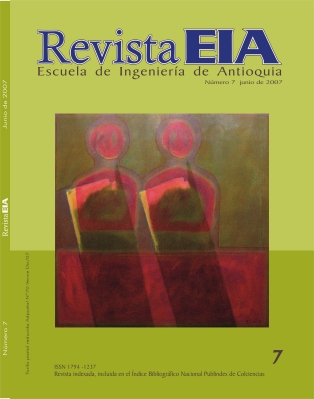DISEÑO DE UNA METODOLOGÍA DE SELECCIÓN DE SITIOS PARA MONORRELLENOS DE LODOS PAPELEROS
DISEÑO DE UNA METODOLOGÍA DE SELECCIÓN DE SITIOS PARA MONORRELLENOS DE LODOS PAPELEROS


This work is licensed under a Creative Commons Attribution-NonCommercial-NoDerivatives 4.0 International License.
Copyright statement
The authors exclusively assign to the Universidad EIA, with the power to assign to third parties, all the exploitation rights that derive from the works that are accepted for publication in the Revista EIA, as well as in any product derived from it and, in in particular, those of reproduction, distribution, public communication (including interactive making available) and transformation (including adaptation, modification and, where appropriate, translation), for all types of exploitation (by way of example and not limitation : in paper, electronic, online, computer or audiovisual format, as well as in any other format, even for promotional or advertising purposes and / or for the production of derivative products), for a worldwide territorial scope and for the entire duration of the rights provided for in the current published text of the Intellectual Property Law. This assignment will be made by the authors without the right to any type of remuneration or compensation.
Consequently, the author may not publish or disseminate the works that are selected for publication in the Revista EIA, neither totally nor partially, nor authorize their publication to third parties, without the prior express authorization, requested and granted in writing, from the Univeridad EIA.
Show authors biography
En el proceso de tratamiento de las aguas residuales de la industria papelera que utiliza fibras recicladas entre sus materias primas, se generan lodos ricos en fibras de celulosa, los cuales al ser deshidratacladas entre sus materias primas, se generan lodos ricos en fibras de celulosa, los cuales al ser deshidratados se llaman residuos papeleros y se han convertido en un problema ambiental, debido a su alta tasa de generación. Internacionalmente se han estudiado varias alternativas de valorización, sin embargo, ninguna se ha implementado en escala industrial en Medellín, Colombia; la necesidad de una disposición adecuada de dichos residuos persiste, por lo que se considera que la forma más inmediata de manejo es mediante su disposición final en el suelo.Unido al problema de la disposición, está la selección del sitio adecuado para realizarla, por lo cual se desarrolló una metodología que permite aplicarse en la evaluación y selección de los sitios optativos para la disposición de los residuos provenientes de las industrias papeleras.
Abstract: The wastewater treatment at paper industry that uses recycled fibers as one of its raw materials genertes a sludge rich in cellulose fibers, which once dehydrated is called “paper waste”. This waste has become an environmental problem because of its high generation rate. Although several alternatives of valorization have been studied, in Medellin none of them has been implemented on an industrial scale; the necessity is still there, that is why the land disposal of this waste appears as the most immediate way to manage it. Combined with the problem of disposition, it is the selection of the suitable site to make it, for which a methodology to be applied in the evaluation and selection of the optative sites for the disposition of remainders of paper industry was developed.
Article visits 237 | PDF visits 154
